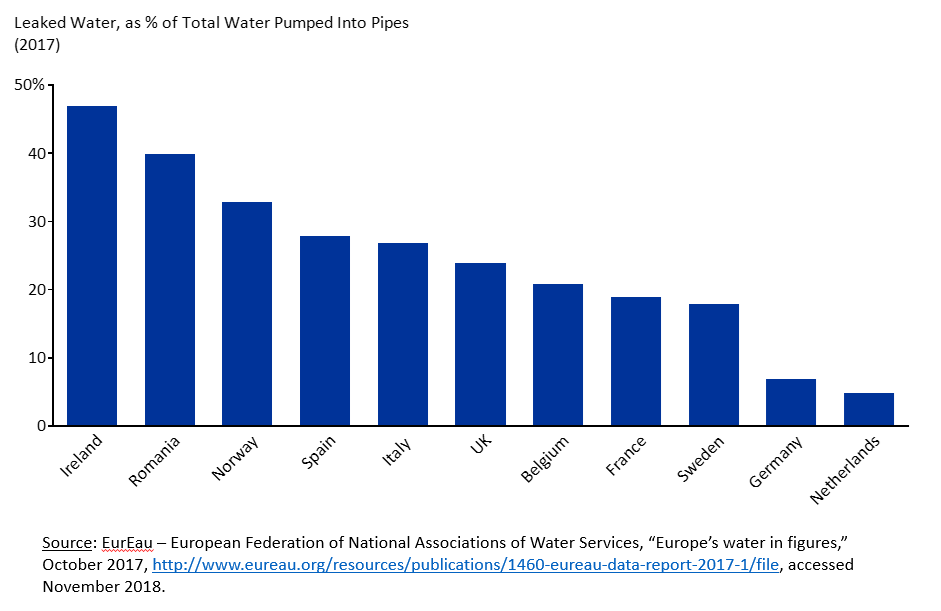Under Pressure: How machine learning can help tackle leakage in European water distribution

What if I told you 3 billion liters of water is leaked into the ground every day in the UK? Exploring how United Utilities is innovating on this issue.
While it may seem surprising in an environmentally-conscious world, 3 billion liters of water is leaked into the ground every day in the UK. To put that into context, that amount could meet the daily needs of 20 million UK consumers[1].
Indeed, many of Europe’s water scarce countries (Spain, Italy and the UK, among others) have an endemic ‘leakage’ problem (see chart below) – up to 50% of treated water pumped into a ‘network’ (i.e., system of underground water pipes), is leaked back into the ground[2][3].
Introducing United Utilities
United Utilities is a publically-listed water and wastewater company serving 3 million households across the North West of England, who themselves leak 430 million liters of water a day[4][5]. According to their regulatory disclosures, between 2020-2025 they plan to spend £1 billion on maintaining and improving their water network, with a significant focus on leakage reduction[6][7].
Process Improvement Potential
Effective leak identification is an extremely important process improvement lever for United Utilities. First, they face severe regulatory scrutiny in this area. Thames Water, a competitor, was fined £120 million last year for failing to hit its leakage targets[8]. Second, there are also significant sunk costs related to leakage; namely, the cost of treating and pumping water before it leaks, alongside the labor costs associated with locating leaks[9].
Leaks can take two forms; overground or underground. Overground leaks are easier to identify, as they are typically reported by customers. For underground leaks, water companies have historically used a field force with acoustic equipment who ‘listen’ to detect anomalies in the flow of a pipe – but such methods are inefficient and costly[10]. United Utilities have also tried other solutions; including training drug-sniffing dogs to detect leaks[11]!
Over the past years, much has been written about the application of machine learning to leak detection. By using historic data related to the flow and pressure levels of water pipes, coupled with the location of previous leaks, a machine can be trained to detect the anomalies that accompany, or foreshadow, leaks[12]. United Utilities is one of the early adopters of these methods.
Machine Learning at United Utilities
In 2017, United Utilities first utilized machine learning with their Event Recognition in Water Network (ERWAN) tool. By teaching the tool based on ~200 million network data-points, it develops a ‘baseline’ for normal operation. When ERWAN detects a deviation from this baseline, it sends a simple alert to operators. In select cases, this has allowed a reduction in response times to overground leaks by ~40%. This technology will be fully embedded over the coming years[13].
For the longer-term, United Utilities have partnered with Emagin to develop a more sophisticated machine learning tool; Hybrid Adaptive Real-Time Intelligence (HARVI). HARVI learns off a wider assortment of data, including weather and electricity data, and runs simulations to suggest an optimal system operating mode. To give an example, if there is a burst it will suggest rerouting water to avoid excessive leakage in this area. Initial results appear promising, with a ~22% cost saving in pilot areas. Regional rollout is expected throughout the 2020-2025 period[14].
Recommendations
In my view, United Utilities management should focus on two areas to build off their initial machine learning success.
First, they must maximize data collection across their network. United Utilities have 42,000 km of water pipes across 3,000 sub-regions[15]. To provide full coverage of potential leak locations, it is estimated they need ~20 sensors per sub-region area, implying they need ~60,000 network sensors[16]. While United Utilities do not publically disclose their current number of sensors, Thames Water have 26,000 sensors/loggers across their water network[17]. Assuming a similar number for United Utilities, given their comparable size, would imply less than 50% coverage. Investment to improve data coverage will allow a machine to accurately pinpoint leak locations across the network.
Second, they should invest to develop truly predictive tools. ERWAN and HARVI are reactive in nature – they respond to leakage events and try to minimize the impact. I believe the best application of machine learning is in predicting where large leaks will occur. For example, with the right data and machine in place, a probability of a major leak can be assigned to each section of pipe. From there, proactive maintenance can be completed on high-risk sections. While this level of sophistication will take time to develop, this should be the ultimate goal of management.
Outstanding Questions
A number of questions remain open for me on this topic; 1) Given that this industry is not a typical destination for machine learning expertise, how can United Utilities attract top talent? 2) How can governments incentivize sharing of technology in competitive markets like this, given the significant societal benefits to doing so? [799 Words]
[1] Henry Bodkin, “Britain to face widespread drought by 2050 unless leaky pipes fixed,” The Telegraph, May 2018, https://www.telegraph.co.uk/news/2018/05/22/water-firms-told-leak-less-officials-warn-widespread-drought/, accessed November 2018.
[2] European Environment Agency, “Water scarcity,” November 2018, https://www.eea.europa.eu/archived/archived-content-water-topic/featured-articles/water-scarcity, accessed November 2018.
[3] EurEau – European Federation of National Associations of Water Services, “Europe’s water in figures,” October 2017, http://www.eureau.org/resources/publications/1460-eureau-data-report-2017-1/file, accessed November 2018.
[4] United Utilities, “About Us,” https://www.unitedutilities.com/about-us, accessed November 2018.
[5] BBC News, “Water chiefs must ‘explain leakage target failures’,” July 2018, https://www.bbc.com/news/uk-44996648, accessed November 2018.
[6] United Utilities, “PR19 Customer Facing Document,” September 2018, https://www.unitedutilities.com/globalassets/z_corporate-site/pr19/c0008_pr19_customer_facing_document.pdf, accessed November 2018.
[7] United Utilities, “United Utilities PR19 Business Plan Submission,” September 2018, https://www.unitedutilities.com/globalassets/z_corporate-site/financial-news-2018/united-utilities-proposed-business-plan-submission.pdf, accessed November 2018. Note: £1 billion calculated by using network proportion of daily bill (19c/105c), multiplied by total planned spend of £5.4 billion.
[8] Gill Plimmer, “Thames Water told to repay users £120m for failing to plug leaks,” Financial Times, June 2018, https://www.ft.com/content/e1257fc4-601a-11e8-ad91-e01af256df68, accessed November 2018.
[9] S. R. Mounce, C. Pedraza, T. Jackson, P. Linford, J. B. Boxall, “Cloud based machine learning approaches for leakage assessment and management in smart water networks,” in 13th International Conference on Computing and Control for the Water Industry, Leicester UK, 2015, pp. 43-52.
[10] G. Kunkel and R. Sturm, “Piloting proactive, advanced leakage management technologies,” American Water Works Association, 103(2) (2011): 62-75.
[11] Telegraph Reports, “Britain’s first water sniffing dog hired to pinpoint leaks and broken pipes”, February 2018, https://www.telegraph.co.uk/news/2018/02/11/britains-first-water-sniffing-dog-hired-pinpoint-leaks-broken/, accessed November 2018.
[12] D. Varies, B. van den Akker, E. Vonk, W. de Jong, J. van Summeren, “Application of machine learning techniques to predict anomalies in water supply networks,” Water Science & Technology: Water Supply, 16(6) (2016): 1528-1535.
[13] United Utilities, “Capital Markets Event,” March 2018, https://www.unitedutilities.com/globalassets/z_corporate-site/financial-news-2018/united-utilities-capital-markets-event-presentation-march-2018.pdf, accessed November 2018.
[14] United Utilities, “Capital Markets Event,” September 2018, https://www.unitedutilities.com/globalassets/z_corporate-site/financial-news-2018/capital-markets-day-presentation-final.pdf, accessed November 2018.
[15] Bloomberg, “Company Overview of United Utilities Group PLC,” https://www.bloomberg.com/research///stocks/private/snapshot.asp?privcapId=408730, accessed November 2018.
[16] David A. Lloyd Owen, Smart Water Technologies and Techniques: Data Capture and Analysis for Sustainable Water Management (Hoboken, NJ: John Wiley & Sons, 2018), pp. 144-145.
[17] Thames Water, “Our leakage performance,” https://www.thameswater.co.uk/help-and-advice/leaks/our-leakage-performance, accessed November 2018.




Colm, great stuff here. I recommend reading Let There Be Water (https://www.amazon.com/Let-There-Be-Water-Water-Starved/dp/1250115566) to get even deeper on the topic.
To your second question, I think the pharma industry is a good comparison – there are a set drugs that would not make sense to commercialize without tax incentives and other more creative solutions. Given that those drugs can save lives, governments have stepped in to make a new market. Perhaps there is room for something similar with water (and indeed other sustainable) technologies. Whether by offering tax incentives or assuring temporary monopolies (e.g., patents for blockbuster drugs) governments could help change the calculus for private corporations.
Echoing Sam’s point that there is room and precedence for the government to intervene on behalf of public good. On the first point of attracting talent, one way United Utilities can do so is through open innovation competitions where they ask the public for solutions to a subset of their larger problem. For example, the US Department of Homeland Security ran a challenge on Kaggle to improve their threat recognition algorithm, with a top prize of $1.5mm. These competitions also act as a recruiting tool, especially for people with top talent but unconventional backgrounds (e.g., not graduating from a top school, not a computer science major).